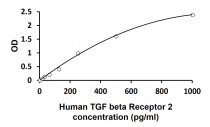ARG81882
Human TGF beta Receptor 2 ELISA Kit
Human TGF beta Receptor 2 ELISA Kit for ELISA and Human
Component
| Cat No | Component Name | Package | Temp |
|---|---|---|---|
| ARG81882-001 | Antibody-coated microplate | 8 X 12 strips | 4°C. Unused strips should be sealed tightly in the air-tight pouch. |
| ARG81882-002 | Standard | 2 X 10 ng/vial | 4°C |
| ARG81882-003 | Standard/Sample diluent | 30 ml (Ready to use) | 4°C |
| ARG81882-004 | Antibody conjugate concentrate (100X) | 1 vial (100 µl) | 4°C |
| ARG81882-005 | Antibody diluent buffer | 12 ml (Ready to use) | 4°C |
| ARG81882-006 | HRP-Streptavidin concentrate (100X) | 1 vial (100 µl) | 4°C |
| ARG81882-007 | HRP-Streptavidin diluent buffer | 12 ml (Ready to use) | 4°C |
| ARG81882-008 | 25X Wash buffer | 20 ml | 4°C |
| ARG81882-009 | TMB substrate | 10 ml (Ready to use) | 4°C (Protect from light) |
| ARG81882-010 | STOP solution | 10 ml (Ready to use) | 4°C |
| ARG81882-011 | Plate sealer | 4 strips | Room temperature |
Overview
| Product Description | ARG81882 Human TGF beta Receptor 2 ELISA Kit is an Enzyme Immunoassay kit for the quantification of Human TGF beta Receptor 2 in serum, plasma (heparin, EDTA) and cell culture supernatants. |
|---|---|
| Tested Reactivity | Hu |
| Tested Application | ELISA |
| Specificity | There is no detectable cross-reactivity with other relevant proteins. |
| Target Name | TGF beta Receptor 2 |
| Conjugation | HRP |
| Conjugation Note | Substrate: TMB and read at 450 nm. |
| Sensitivity | 7.8 pg/ml |
| Sample Type | Serum, plasma (heparin, EDTA) and cell culture supernatants. |
| Standard Range | 15.6 - 1000 pg/ml |
| Sample Volume | 100 µl |
| Precision | Intra-Assay CV: 5.3%; Inter-Assay CV: 6.0% |
| Alternate Names | FAA3; AAT3; TbetaR-II; TGF-beta receptor type-2; LDS2B; MFS2; TGF-beta type II receptor; EC 2.7.11.30; TAAD2; TGFR-2; LDS2; Transforming growth factor-beta receptor type II; TGFbeta-RII; TGF-beta receptor type II; RIIC; LDS1B |
Application Instructions
| Assay Time | ~ 5 hours |
|---|
Properties
| Form | 96 well |
|---|---|
| Storage Instruction | Store the kit at 2-8°C. Keep microplate wells sealed in a dry bag with desiccants. Do not expose test reagents to heat, sun or strong light during storage and usage. Please refer to the product user manual for detail temperatures of the components. |
| Note | For laboratory research only, not for drug, diagnostic or other use. |
Bioinformation
| Database Links | |
|---|---|
| Gene Symbol | TGFBR2 |
| Gene Full Name | transforming growth factor, beta receptor II (70/80kDa) |
| Background | This gene encodes a member of the Ser/Thr protein kinase family and the TGFB receptor subfamily. The encoded protein is a transmembrane protein that has a protein kinase domain, forms a heterodimeric complex with another receptor protein, and binds TGF-beta. This receptor/ligand complex phosphorylates proteins, which then enter the nucleus and regulate the transcription of a subset of genes related to cell proliferation. Mutations in this gene have been associated with Marfan Syndrome, Loeys-Deitz Aortic Aneurysm Syndrome, and the development of various types of tumors. Alternatively spliced transcript variants encoding different isoforms have been characterized. [provided by RefSeq, Jul 2008] |
| Function | Transmembrane serine/threonine kinase forming with the TGF-beta type I serine/threonine kinase receptor, TGFBR1, the non-promiscuous receptor for the TGF-beta cytokines TGFB1, TGFB2 and TGFB3. Transduces the TGFB1, TGFB2 and TGFB3 signal from the cell surface to the cytoplasm and is thus regulating a plethora of physiological and pathological processes including cell cycle arrest in epithelial and hematopoietic cells, control of mesenchymal cell proliferation and differentiation, wound healing, extracellular matrix production, immunosuppression and carcinogenesis. The formation of the receptor complex composed of 2 TGFBR1 and 2 TGFBR2 molecules symmetrically bound to the cytokine dimer results in the phosphorylation and the activation of TGFRB1 by the constitutively active TGFBR2. Activated TGFBR1 phosphorylates SMAD2 which dissociates from the receptor and interacts with SMAD4. The SMAD2-SMAD4 complex is subsequently translocated to the nucleus where it modulates the transcription of the TGF-beta-regulated genes. This constitutes the canonical SMAD-dependent TGF-beta signaling cascade. Also involved in non-canonical, SMAD-independent TGF-beta signaling pathways. [UniProt] |
| Highlight | Related products: TGF beta Receptor antibodies; TGF beta Receptor ELISA Kits; New ELISA data calculation tool: Simplify the ELISA analysis by GainData |
| PTM | Phosphorylated on a Ser/Thr residue in the cytoplasmic domain. [UniProt] |
Images (1) Click the Picture to Zoom In
| Title | Download Link |
|---|---|
| ARG81882 Human TGF beta Receptor 2 ELISA Kit User's manual |
 Download Download
|






